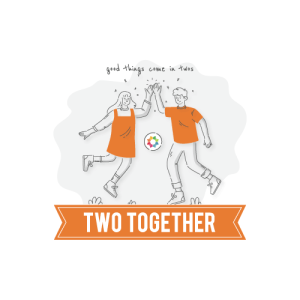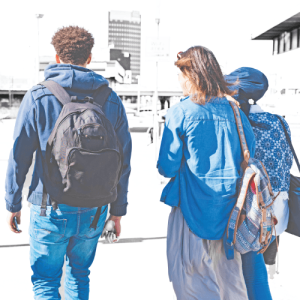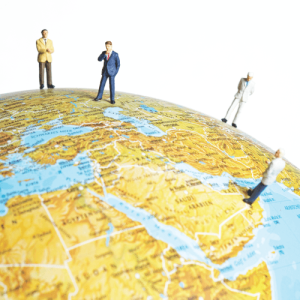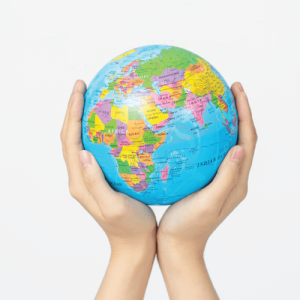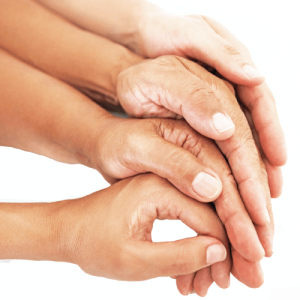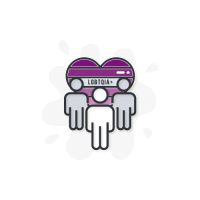
How the Worldwide LGBTQIA+ Population Index was calculated

The LGBTQIA+ Population index is collated using conservative estimates, and the figures are based on those reported and published by each country annually. Though conservative, it is likely that the actual global population relating to the community is much more significant due to more countries becoming more inclusive and introducing laws and protections relating to the LGBTQIA+ communities.
Through years of research and vocal advocates and pioneers from within the LGBTQIA+ community, the world is starting to understand that sexual or gender identities are not something a person chooses. Instead, you are simply born that way. With no official censuses, it is hard to establish the actual size of the worldwide LGBTQIA+ community, with many hiding their true identity for fear of persecution
Country population statistics are typically established by using:
- The total number of individuals that were living in that country for the previous year
- The total number of births and deaths
- The total number of people that have left the country (emigrated) and those that have moved to the country (immigrated)
By combining all of those various factors, it is easy to establish the number of people living in any given country for a specific point of time, their gender and age; however, to understand more about a person, governments will often carry out censuses where more detailed information is obtained. Censuses are expensive and time-consuming to arrange, so typically, they are not carried out frequently, usually any period from five to ten years or more between each census.
The questions asked in the census help to understand more about attitudes, behaviours and preferences; however, there has been no official world census regarding the LGBTQIA+ community. Research and studies have been carried out in which the estimates of LGBTQIA+ individuals range dramatically, with some estimating as high as 15% of the population identifying as LGBTQIA+ in one particular country. With no official census or the means to accurately capture the actual number of LGBTG+ individuals, it is necessary to provide reasonable estimates.
POPULATION STATISTICS
The LGBTQIA+ population volumes are based on several averages that helped us to establish the following conservative estimates against the total population:
- Lesbian & Gay – 1.3444%
- Bisexual – 1.2889%
- Transgender – 0.0060%
- Total – 2.6393%
The index has been compiled from country-specific information obtained from the U.S. Census Bureau |International Programs | International Database
EXCEPTIONAL AND DIVERSE LGBTQIA+ COMMUNITY

LGBTQIA+ COUNTRY & REGION GUIDES
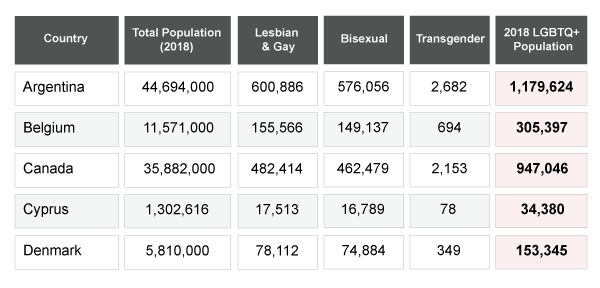
- We start by multiplying the official population against the estimated Lesbian and Gay ratio (1.34444444444444%)
- We then multiply the official population against the estimated Bisexual ratio (1.28888888888889%)
- Lastly, we multiply the official population against the transgender ratio (0.006%)
- Once we have the volumes for each of the groups, we are now able to establish the total population size for each country
EXCEPTIONAL PEOPLE MAKING HISTORY

Historically, countries worldwide have avoided using sexuality or gender identity-related questions as part of the censuses or electoral roles. Without the question sets, people from the LGBTQIA+ community cannot be identified and included in official statistics. Though some countries are slowly beginning to have the relevant questions on forms, only a handful of countries encourage community members to be identified and counted amongst the population statistics.
Even with tailored questions relating to the LGBTQIA+ community, there are other barriers, some generational in which some older community members still find it hard to be open about their gender or sexuality on official polls and censuses. Also, there are concerns about sharing personal information about their gender or sexual identity in countries that are only starting to become more inclusive. Given the stigmatism that still exists and the fact that a change of government or a shift in popular opinion could instantly change things for them, making them targets by being honest about who they are.
Without any official statistics, non-profit organisations, pollsters, and those who analyse trends and movements have predicted that in some countries, such as the USA, the number of people who identify as LGBTQIA+ could be as high as 15% of the total population. In countries where the government is hostile towards the community, many will likely hide their sexuality or gender identity for fear of being targeted and persecuted. The LGBTQIA+ estimates used within the population index are based on various articles, research papers, and studies worldwide over the past twenty-plus years. The LGBTQIA+ population estimates are at a country level, enabling population trends and statics for individual countries, regions and sub-regions.
Based on the average from various published reports, a conservative estimate is approximately 2.6% of the world’s population identifies as LGBTQIA+. From a community perspective, it is difficult to further breakdown those estimates at a micro-level relating to individual groups; however, the population index is based on:
- Lesbian & Gay – 1.3444%
- Bisexual – 1.2889%
- Transgender – 0.0060%
- Total – 2.6393%
Understanding, even as an estimation, the size of the global LGBTQIA+ community is essential. It reinforces that people who identify as LGBTQIA+ live within every country worldwide, are from every race, and religious denomination, and are all part of the society of the countries they live within. Further validating that they have no choice around who they are often at significant risk to their personal safety. Identifying as gay, lesbian, bisexual, transgender, or any of the groups with non-traditional gender and sexual identities is not a choice but an acceptance of who they are.
LGBTQIA+ and straight people are not different; they all want the same things. To receive their fundamental human rights, to receive an education, to have access to healthcare, to receive a fair wage, and of course, to love whomever they wish. Countries across the globe are changing. Hopefully, we will have a worldwide census with the actual number of LGBTQIA+ people living worldwide one day. In a world where people can be honest and be counted without fear of persecution.
TAKING PRIDE IN YOU
Gayther...your community resources
Three dedicated websites offer various tools, services, guides, and much more. Free tools and services tailored toward all groups within the global LGBTQIA+ community
There are thousands of events taking place, it is not always easy to know what is going on and when, Gayther can help
SMARTPHONE SHORTCUTS & BOOKMARKS
IMPORTANT DISCLAIMER: The LGBTQIA+ population index is based on conservative estimates relating to the global community’s size, which has been applied to the total population for a given year. We cannot accurately confirm the actual number of LGBTQIA+ individuals living within any given country. There are no official censuses that focus specifically on sexual orientations or gender identities; therefore, the volumes are based on reasonable estimates. We acknowledge that the actual size may be higher or lower than our estimates in certain countries. The index is a global index and will include countries where identifying as LGBTQIA+ is considered illegal or where the individual is likely to be persecuted. The estimates are applied to the entire world population. The index is for illustration purposes only and is not a census or tool to single out or isolate a proportion of any given country’s population. It is essential that before travelling that you independently establish information relating specifically to your own requirements and circumstances. Though we endeavour to keep all information across the site updated, we do not provide any guarantees of the accuracy and completeness of any information displayed. This page may contain external links to third-party websites; Gayther provides these links for your convenience and does not endorse, warrant or recommend any particular products or services. By clicking on any external links, you will leave Gayther and be taken to the third-party website, which you do so at your own risk and by accessing the site, you will be required to comply with the external third party’s terms and conditions of use and privacy policies





